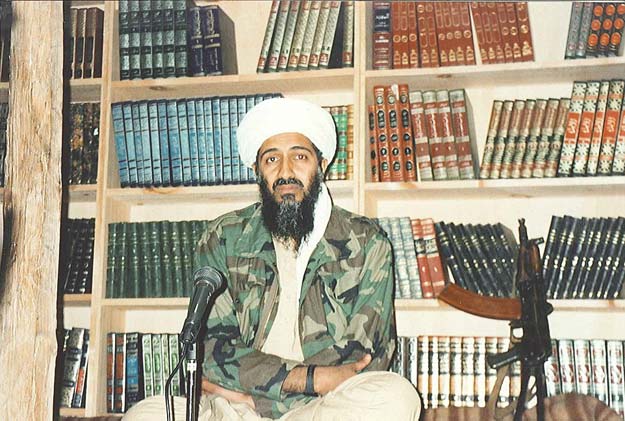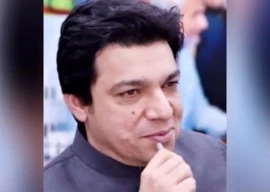

Osama Bin Laden holds a Kalashnikov rifle in Tora Bora, a mountainous region of Afghanistan, in November, 1996. The al Qaeda leader spent years developing a network of tunnels and caves in the area. PHOTO: UNITED STATES ATTORNEY’S OFFICE SOUTHERN DISTRICT OF NEW YORK
The rare pictures resurfaced in February during a terrorism conspiracy trial in New York of al Qaeda lieutenant Khaledal Fawwaz a communication conduit for the terrorist organisation in London during the mid-1990s.
The photos that give a glimpse into the lifestyle of the al Qaeda chief were taken by Palestinian journalist Abdel Barri Atwan, who was invited to the hideout in 1996 as part of a plan initiated by Bin Laden to spread the message of hate to the Western World.

The terrorist mastermind had, by this point, declared war on the United States and tried to use international press coverage to spread the word. PHOTO: UNITED STATES ATTORNEY’S OFFICE SOUTHERN DISTRICT OF NEW YORK
The brains behind the September 11, 2001, twin tower attacks had declared a war on the United States and planned a media campaign to garner international attention.

The militant would sit in front of shelves filled with copies of the Holy Quran. PHOTO: UNITED STATES ATTORNEY’S OFFICE SOUTHERN DISTRICT OF NEW YORK
His media campaign also included his first ever television interview for CNN in 1997 and a sit-down for ABC News a year later.
"He wanted media exposure," a CNN correspondent told Peter Bergen for his 2006 book, The Osama Bin Laden I Know.

A smiling Bin Laden is seen walking around Tora Bora surrounded by bodyguards, loyal followers and family members. PHOTO: UNITED STATES ATTORNEY’S OFFICE SOUTHERN DISTRICT OF NEW YORK
"He wants to say, 'Now I am an international figure; I'm not just a Saudi. I am aggrieved at Americans who are occupying Saudi Arabia who are desecrating the Holy Land'," he had said.

He sits alongside Syrian-born ideologue Abu Musab al-Suri, a Bin Laden ally who once ran training camps inside Afghanistan. PHOTO: UNITED STATES ATTORNEY’S OFFICE SOUTHERN DISTRICT OF NEW YORK
Bin Laden always made video announcements in front of shelves filled with copies of the Holy Quran and was often captured with a smirk on his face as he took evening strolls in the isolated compound.

The rare pictures were yielded by Palestinian journalist Abdel Barri Atwan (right) during an interview in 1996. Bin Laden wanted the media coverage to project his status as an international terrorist leader. PHOTO: UNITED STATES ATTORNEY’S OFFICE SOUTHERN DISTRICT OF NEW YORK
For many years, he developed an elaborate network of caves 14,000ft up in the White Mountains.
Bin Laden discovered the area in the 1980s, and decided to set up the compound in 1996 – when the Taliban had control of Afghanistan.

Dozens of fighters would accompany him on the long walks. They would stay in the compound alongside Bin Laden's multiple wives and children. PHOTO: UNITED STATES ATTORNEY’S OFFICE SOUTHERN DISTRICT OF NEW YORK
The location was chosen because of its proximity to the border of Pakistan and of course because of the rough terrain that would make it strenuous for opposition forces to attack on foot.
Further, the structure of caves and underground passages meant he would also be protected from aerial attacks.

One of Bin Laden’s hideaways was made mud and stone and propped up by wooden strut. PHOTO: UNITED STATES ATTORNEY’S OFFICE SOUTHERN DISTRICT OF NEW YORK
He once said in an interview: "I feel really secure in the mountains."
Reports suggest that Bin Laden would spend hours on long hikes in the mountains with a Russian-made Kalashnikov by his side.

Pictured is a secret passageway - part of the intricate network that lay in the mountainside. Bin Laden told his sons they had to know well the tunnel network in case the area came under attack. PHOTO: UNITED STATES ATTORNEY’S OFFICE SOUTHERN DISTRICT OF NEW YORK
Several of his bodyguards, fellow militants and his children would constantly follow him around as he looked for new places to hide out in.
Bin Laden had emphasised to his family that they needed to know the tunnel and terrain system thoroughly in case of an attack.

Bin Laden speaks to al-Suri during a two-hour hike across the mountains. Journalist Atwan said: 'He loved the nature there. He loved the mountain. They were trying to have their own community'. PHOTO: UNITED STATES ATTORNEY’S OFFICE SOUTHERN DISTRICT OF NEW YORK
The compound, buried beneath snow-covered mountains was primitive and only connected to the nearest city of Jalalabad by a dirt road.
During the visit, Palestinian journalist Atwan took a picture of a two-bedroom house made of mud and stone Bin Laden is believed to have shared with his wives and family.

From left, inside a cave, are al-Suri, bin Laden and British documentary maker Gwynne Roberts. PHOTO: UNITED STATES ATTORNEY’S OFFICE SOUTHERN DISTRICT OF NEW YORK
Bin Laden’s children were believed to have suffered from constant hunger, with a limited died of eggs, rice and cheese.
The terrorist leader remained in the compound until 2001 when Western forces traces him down and targeted the compound with constant air strikes.
Months after 9/11 in December, an assault forced Bin Laden to flee the area on horseback and slip into Pakistan or northern Afghanistan.

Al-Suri, seen here taking photos, published online 'The Call for Global Islamic Resistance' in 2004, saying there need not be any organizational bonds between 'resistance fighters'. PHOTO: UNITED STATES ATTORNEY’S OFFICE SOUTHERN DISTRICT OF NEW YORK
After Bin Laden relocated, the hunt expanded in the Kunar border zone. In 2003, US soldiers attacked the hideouts of Bin Laden's military chief Kashmir Khan, slightly wounding him.
In 2005, a US special forces Chinook helicopter was shot down in Kunar, killing all 16 personnel on board.
The 10-year search for him ended on May 2, 2011, when he was killed during a Navy Seal operation in Abbottabad.
This article originally appeared in Mail Online.

















COMMENTS (3)
Comments are moderated and generally will be posted if they are on-topic and not abusive.
For more information, please see our Comments FAQ